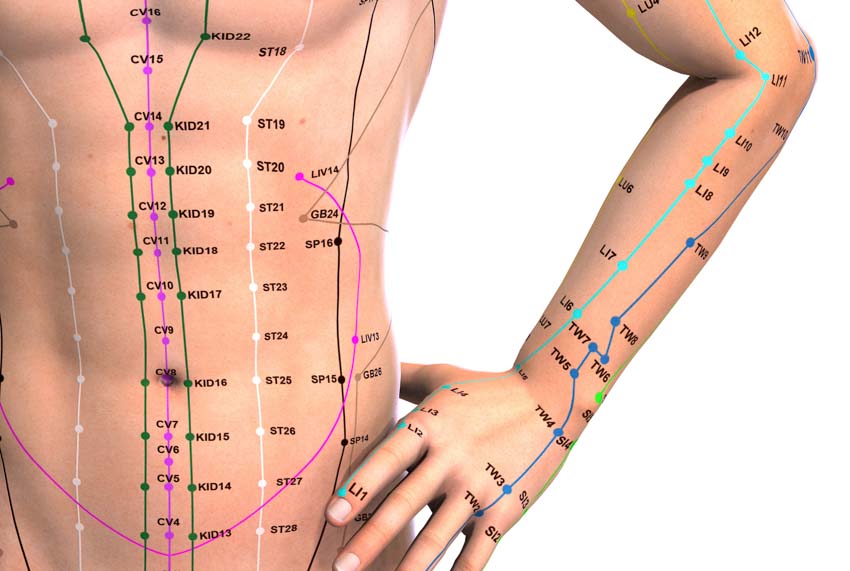
Acupuncture is effective for the treatment of lateral epicondylitis, a painful condition of the tendons usually caused by overuse of the elbow and often referred to as tennis elbow. Researchers at the Dengfeng Community Health Service Center (Yuexiu District, Guangzhou) conducted a clinical trial comparing abdominal acupuncture monostherapy and abdominal acupuncture combined with warm needle acupuncture treatments. Both methods benefitted the patients, but the latter approach yielded better results with a total efficacy rate of 90.48%. [1]
A total of 42 lateral epicondylitis patients were admitted into the study. The abdominal acupuncture monotherapy control group was composed of 21 patients; seven had undergone regional blockade, three had been treated with needle knife, five had done physiotherapy, and six had used massage. The average age in this group was 45.52 ±22.54 years. The average course of disease was 10.53 ±9.52 months.
The abdominal acupuncture combined with warm needle acupuncture group was composed of 21 patients; nine had undergone regional blockade, three had been treated with needle knife, four had done physiotherapy, and five had used massage. The average age in this group was 41.37 ±21.54 years. The average course of disease was 7.14 ±16.15 months.
There were no significant statistical differences in age, course of disease, or previous treatment in the two groups of patients initially admitted to the study. All patients experienced radiating and progressive pain from the lateral aspect of the elbow into the forearm and wrist. Movements at these areas aggravated the pain. Inflammation could be observed in fracturesthe muscles and fascia.
Acupuncture Points
For the abdominal acupuncture monotherapy control group, patients took a supine position. The acupoints ST24 (Hua Rou Men) and Shang Feng Shi Dian on the affected side of the body, as well CV12 (Zhongwan) and KD17 (Shangqu) on the unaffected side were used. Shang Feng Shi Dian is an extra point located 0.5 cun above and 0.5 cun lateral to ST24.
Needles were inserted and twisted slowly and gently. A deqi sensation was elicited. Needles were retained for 10 minutes and then twisted again to obtain deqi. Then, needles were retained for 30 minutes.
The abdominal acupuncture combined with warm needle acupuncture treatment group first used the same abdominal acupuncture procedure as in the above group. Then, two of the most painful points at the elbow joints and GB20 (Fengchi) were given warm needle acupuncture. Filiform needles (0.30 mm × 50 mm) were inserted perpendicularly to a needling depth of 1–1.5 cun. Moxa, 1 cm in length, was attached to the needle ends. Treatments were given for five to ten days, according to patients’ tolerance level. A four-level symptom scoring system was used to assess the outcome of the treatment:
- Recovered: pain eliminated and mobility restored
- Significantly effective: pain relieved to a tolerable level and mobility restored
- Effective: pain slightly relieved and mobility improved
- Ineffective: pain and immobility persisted
Among the 21 patients in the abdominal acupuncture monotherapy group, 7 recovered, 5 were significantly effective, 3 were effective, and 6 were ineffective. Total efficacy rate was 71.43%.
Among the 21 patients in the abdominal acupuncture combined with warm needle acupuncture treatment group, 7 recovered, 5 were significantly effective, 3 were effective, and 6 were ineffective. Total efficacy rate was 90.48%.
Level of pain was recorded as well. The figure of the abdominal acupuncture combined with warm needle acupuncture treatment group dropped more markedly from 6.04 ±0.85 to 1.61 ±1.97. In comparison, the abdominal acupuncture monotherapy group underwent a smaller decline from 6.13 ±0.87 to 3.71 ±1.94.
The results show that the addition of warm needle acupuncture to abdominal acupuncture in the treatment of lateral epicondylitis is successful in relieving pain and enhancing clinical efficacy.
Reference:
[1] Shan Xingkai, Zhang Fangnuan, Yu Liugui, Clinical Efficacy of Treating Lateral Epicondylitis with an Integral Approach of Abdominal Acupuncture and warm needle acupuncture, Inner Mongolia Journal of Traditional Chinese Medicine, Vol.40, No. 8, 2021.


